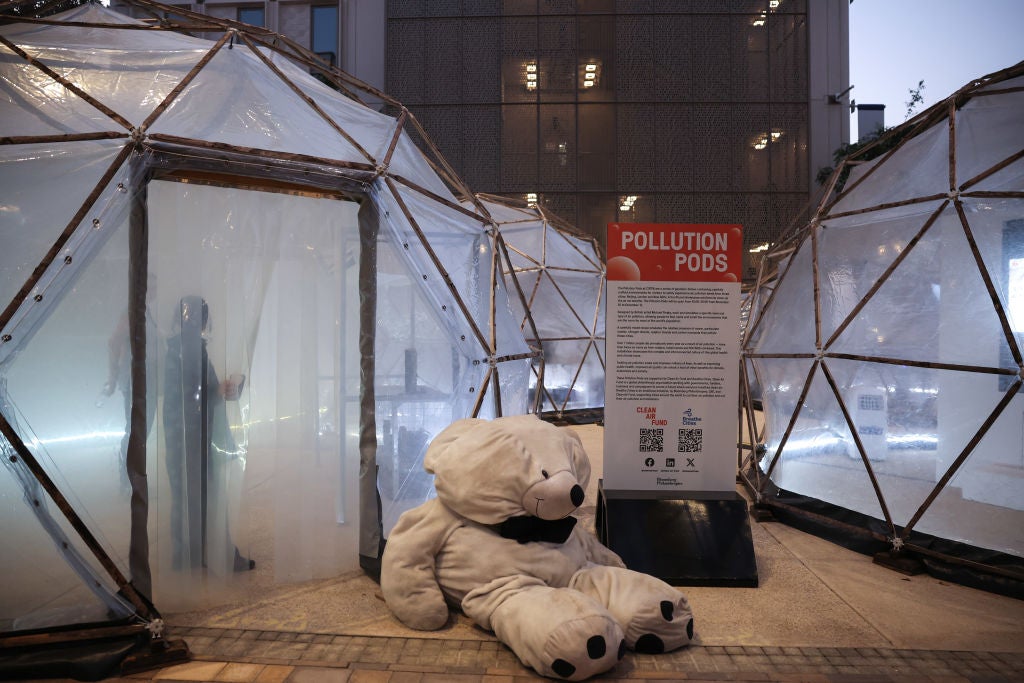
DUBAI – Nestled between the hundreds of pavilions in COP28’s sprawling Blue Zone were four geodesic domes. The igloo-like structures, called “pollution pods”, simulated the air pollution levels of three cities: Beijing, New Delhi and London, along with a fourth pod that allowed visitors to experience clean air. They were there to draw attention to the links between climate change, air pollution and health – through emissions like black carbon – at COP28.
Designed by British artist Michael Pinsky, each pod contained a carefully calibrated blend of gases to simulate the nitrogen dioxide, sulphur dioxide, carbon monoxide and other pollutants that are typically present in each city.
Beijing’s pod, full of hazy, plastic-scented steam, simulated a day of “very high” pollution. New Delhi’s – where air pollution reduces life expectancy by 12 years on average – was humid and dense, with a smoky edge from the burning of rice stubble in paddy fields near the city. London’s pod, which simulated “moderate” pollution, was comparatively clear; if anything, a hint of diesel.

The pods were funded by the Clean Air Fund (CAF), a philanthropic foundation tackling global air pollution, along with its new $30m (£23.74m) clean air initiative, Breathe Cities, which was created by CAF in partnership with Bloomberg Philanthropies and C40 Cities, a global network of mayors working together on climate action.
CAF aims to tackle all kinds of air pollution, but a particular focus for the organisation at the moment is ‘black carbon’, or soot. This is a component of fine particulate matter (PM2.5) air pollution, part of a “family of largely gaseous pollutants that are short-lived, but intensely climate warming”, explains Sean Maguire, strategic partnerships and communications director at CAF, speaking to Energy Monitor in Dubai.
The “most famous” short-lived climate pollutant is methane, which has an atmospheric lifetime of 12 years, compared with hundreds of years for CO₂ but which has a warming impact up to 80-times stronger.
What is black carbon?
Black carbon particles are produced from the incomplete combustion of fossil fuels, wood or other biomass. They are emitted along with CO₂, carbon monoxide and other air pollutants. Black carbon’s sources vary between regions: in Asia and Africa, 60–80% of black carbon emissions come from fuels like coal and biomass, which are burned in the home. In Europe and North America, black carbon comes mainly from diesel engines.
The impacts of black carbon also vary between regions: the ‘cryosphere’, or snowy areas – in particular the Arctic, where warming is four-times faster than anywhere else in the world – is most vulnerable to the impacts of black carbon, found a report published on 1 December by CAF. Black carbon “significantly influences” regional surface temperatures, with a warming effect approximately three-times as strong as CO₂, the report finds. This fuels a “climate feedback loop of decreased snow and ice cover and increased regional warming”, known as ‘Arctic amplification’. This has global-scale climate impacts; for example, affecting global monsoon patterns and aridification in places like California, and taking us closer to “irreversible climate tipping points”, Maguire explains.
“This will have devastating effects on our overall climate systems,” says Maguire. “Black carbon emissions have to be reduced.”
Despite posing significant environmental and health risks, attention on black carbon has “lagged”, concludes CAF’s report. At the time of publication, only a small number of countries including Ghana, Mexico and Eswatini had incorporated black carbon targets into their nationally determined contributions (NDCs) under the Paris Agreement. Black carbon is not explicitly part of any climate protocol such as the Paris Agreement, “revealing a significant gap in climate strategy”, the report finds.
Black carbon creeps into COP28
However, in the run-up to COP28, black carbon found its way onto the conference agenda by riding a wave of heightened attention on non-CO₂ pollutants. Two weeks before COP28 began, the US and China agreed to set NDCs for 2035 that are “economy-wide, [and] include all greenhouse gases”, as a part of a bilateral climate deal signed at Sunnylands, California.
“In some ways, that recommendation of ours [that black carbon be integrated into international climate targets] has been swept up already,” said Maguire in Dubai.
COP28 also saw a $450m pledge from leading climate philanthropies to deepen investment in ‘super pollutants’ including fluorinated gases, nitrous oxide, black carbon and ground-level ozone. Previous such investments have included financing for projects like the World Bank’s Lighting Africa programme, which has increased access to “affordable high-quality off-grid solar lighting” in parts of West Africa, where widespread use of kerosene wick lamps generate high levels of black carbon pollution, reports CAF. In these regions, black carbon emissions have disrupted monsoon patterns, resulting in widespread flooding. Now, it suggests investors could work with local banks to create innovative financing models that facilitate funding towards projects like Lighting Africa, supported by grants from governments and international donors.
Keep up with Energy Monitor: Subscribe to our weekly newsletterChina and the US’ new focus on “economy-wide” emissions was endorsed by COP28 President Sultan Al Jaber on day two of the conference; a “great” development, said Maguire, because it will lead countries to start measuring the climate footprint of non-CO₂ pollutants such as black carbon and methane. Currently, short-lived pollutants are not “measured with the same accuracy” as CO₂, he noted. However, Maguire added that black carbon accounting is trickier than CO₂ because its impacts differ by locality: “A gram of black carbon is less damaging to the planet in central France than it is in northern Norway.”
Non-carbon emissions in the final COP28 text
References to non-CO₂ pollutants made it into the final draft of the Global Stocktake text, the primary outcome of COP28 and a response to the global climate challenge. The final version of the cover text, agreed by all 198 parties of the UN Framework Convention on Climate Change, calls on countries to “recognize” the need for “substantially reducing non-carbon-dioxide emissions globally, including, in particular, methane emissions, by 2030″.
While undoubtedly a positive development, the final wording is weaker than in earlier versions of the text. For example, a draft published on 8 December, four days before COP28 concluded, specifically asked parties to aim to reduce methane emissions globally by at least 30% by 2030 and 40% by 2035. The 30% by 2030 goal is in line with a Global Methane Pledge led by the EU and US in 2021.
“[Nevertheless] a consensus has emerged that targeted approaches to non-CO₂ climate forcers are essential for fast climate mitigation,” said Jenaina Irani, an analyst at CAF, speaking to Energy Monitor on the penultimate day of COP28. “[Now, countries] must show increased ambition by setting black carbon targets that go above and beyond existing net-zero plans in their NDCs. Multilateral development banks and donor governments must support countries with grant and concessional finance to track emissions and realise these targets,” she added.
“Double dividends” for health and climate
By inviting visitors to breathe the dirty air of three of the world’s most polluted cities, CAF’s pollution pods push us to consider the health impacts of air pollution, which are worsened by the impacts of climate change. A recent study published in the British Medical Journal shows that eight million excess deaths each year are attributable to air pollution. While there is no data showing the number of deaths specifically caused by black carbon, a 2021 study published in Science Direct finds a “significant association” between long-term exposure to black carbon and death from all causes.
A growing awareness of the link between climate change and health meant that this year, COP28 had the first-ever Health Day, on 3 December. On this day, Jane Burston, CAF founder, invoked the name of Ella Kissi-Debrahf, a young girl from Lewisham, London, UK, who died in 2013, and after a lengthy inquest, became the first person in the world to have air pollution listed as a cause of death on her death certificate in 2020. “I hope Ella will one day get justice,” Burston said during her talk.
Reducing emissions from fossil fuels will “deliver the double dividends” of reducing climate and health impacts, says Maguire. He adds that acting on air pollution is often “politically easier” for governments to do than acting on climate change, given that people are more likely to respond to the personal benefits of cleaner air.
At COP28, pollution was a very tangible concept, with attendees likely to have encountered the heavy smog that descends on Dubai most mornings on their way to the conference venue, Expo City, located just seven miles from the world’s largest gas-fired power plant. While many have argued that the COP28 final text is riddled with a “litany of loopholes”, the explicit commitment from signatory countries to “transition away from fossil fuels in energy systems”, along with the mention of non-CO₂ gases, is a step towards reaping dual benefits for climate and health.



